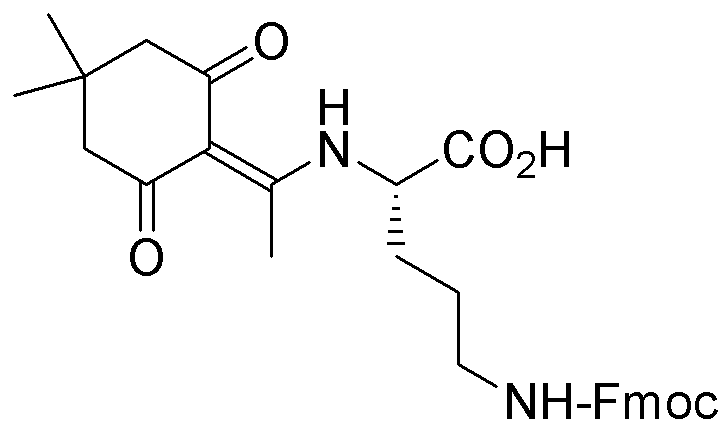Na-1-(4,4-dimethyl-2,6-dioxocyclohex-1-ylidene)ethyl-Nd-Fmoc-L-ornitine is widely utilized in research focused on
- Peptide Synthesis: This compound serves as a key building block in the synthesis of peptides, which are essential for developing new drugs and therapies.
- Drug Development: Its unique structure allows for the design of novel pharmaceuticals, particularly in targeting specific biological pathways, enhancing efficacy and reducing side effects.
- Bioconjugation: It is used in bioconjugation processes to attach biomolecules to drugs, improving delivery mechanisms and therapeutic outcomes in targeted therapies.
- Research in Cancer Therapeutics: The compound is explored for its potential in cancer treatment, as it can be modified to create compounds that selectively target cancer cells.
- Biomaterials: Its properties make it suitable for developing biomaterials that can be used in tissue engineering and regenerative medicine, providing scaffolds that support cell growth.
General Information
Properties
Safety and Regulations
Applications
Na-1-(4,4-dimethyl-2,6-dioxocyclohex-1-ylidene)ethyl-Nd-Fmoc-L-ornitine is widely utilized in research focused on
- Peptide Synthesis: This compound serves as a key building block in the synthesis of peptides, which are essential for developing new drugs and therapies.
- Drug Development: Its unique structure allows for the design of novel pharmaceuticals, particularly in targeting specific biological pathways, enhancing efficacy and reducing side effects.
- Bioconjugation: It is used in bioconjugation processes to attach biomolecules to drugs, improving delivery mechanisms and therapeutic outcomes in targeted therapies.
- Research in Cancer Therapeutics: The compound is explored for its potential in cancer treatment, as it can be modified to create compounds that selectively target cancer cells.
- Biomaterials: Its properties make it suitable for developing biomaterials that can be used in tissue engineering and regenerative medicine, providing scaffolds that support cell growth.
Documents
Safety Data Sheets (SDS)
The SDS provides comprehensive safety information on handling, storage, and disposal of the product.
Product Specification (PS)
The PS provides a comprehensive breakdown of the product’s properties, including chemical composition, physical state, purity, and storage requirements. It also details acceptable quality ranges and the product's intended applications.
Certificates of Analysis (COA)
Search for Certificates of Analysis (COA) by entering the products Lot Number. Lot and Batch Numbers can be found on a product’s label following the words ‘Lot’ or ‘Batch’.
*Catalog Number
*Lot Number
Certificates Of Origin (COO)
This COO confirms the country where the product was manufactured, and also details the materials and components used in it and whether it is derived from natural, synthetic, or other specific sources. This certificate may be required for customs, trade, and regulatory compliance.
*Catalog Number
*Lot Number
Safety Data Sheets (SDS)
The SDS provides comprehensive safety information on handling, storage, and disposal of the product.
DownloadProduct Specification (PS)
The PS provides a comprehensive breakdown of the product’s properties, including chemical composition, physical state, purity, and storage requirements. It also details acceptable quality ranges and the product's intended applications.
DownloadCertificates of Analysis (COA)
Search for Certificates of Analysis (COA) by entering the products Lot Number. Lot and Batch Numbers can be found on a product’s label following the words ‘Lot’ or ‘Batch’.
*Catalog Number
*Lot Number
Certificates Of Origin (COO)
This COO confirms the country where the product was manufactured, and also details the materials and components used in it and whether it is derived from natural, synthetic, or other specific sources. This certificate may be required for customs, trade, and regulatory compliance.


